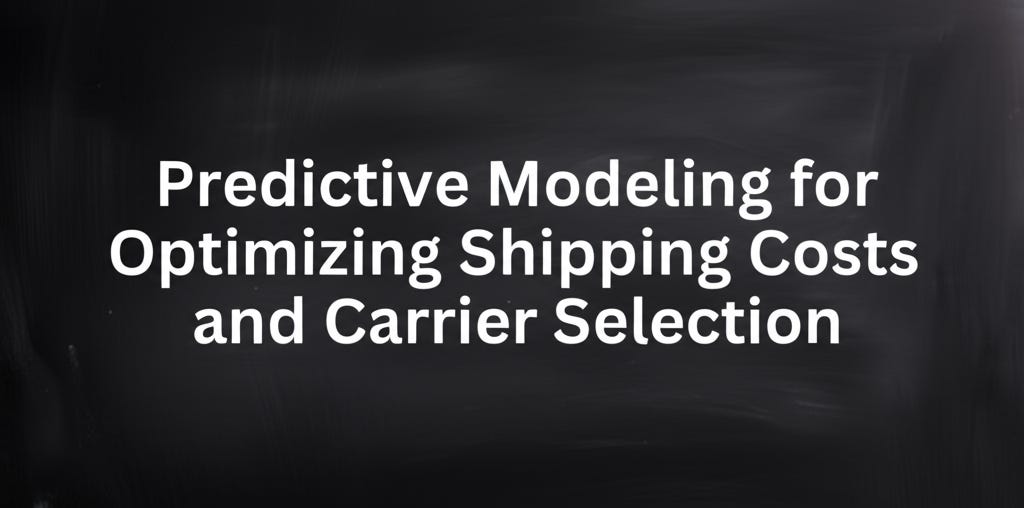ML Case-study Interview Question: Predictive Modeling for Optimizing Shipping Costs and Carrier Selection
Browse all the ML Case-Studies here.
Case-Study question
A global online platform faces spiraling delivery costs. They have massive order volumes with varying delivery zones. They want to reduce operational expenses by predicting optimal shipping routes and carrier selections. They provide historical shipping data, user demographics, item dimensions, and shipment outcomes. They seek a modeling strategy to minimize shipping expenses while preserving fast delivery. Propose a detailed data science approach and explain how you would prototype, validate, and deploy this solution at scale.
Proposed Solution
Data collection starts with merging tables of user, item, and shipping details. Missing records appear when dispatch fails or addresses are incomplete. Fix that by cross-referencing location data. Filter out extreme anomalies like unusual package sizes to reduce noise.
Feature engineering identifies relevant attributes such as user region, item weight, item dimensions, and shipping route mileage. Generate interaction features like user_region x item_weight. Create date-based features like season or day-of-week.
Model selection starts with a supervised approach. Choose a classification model to predict optimal carrier from past data. In parallel, set up a cost regression model to estimate shipping costs. Compare predicted carriers to actual carriers to see if changes yield cost reductions without harming speed.
Implementation uses a pipeline. Data ingestion. Feature transformations. Model training. Model performance checks. Pipeline can rely on Python. A possible snippet for a pipeline stage follows.
import pandas as pd
from sklearn.model_selection import train_test_split
from sklearn.preprocessing import StandardScaler
from sklearn.linear_model import LogisticRegression
df = pd.read_csv("shipping_data.csv")
X = df[["user_region", "item_weight", "distance_miles", "day_of_week"]]
y = df["optimal_carrier"]
X_train, X_test, y_train, y_test = train_test_split(X, y, test_size=0.2)
scaler = StandardScaler()
X_train_scaled = scaler.fit_transform(X_train)
model = LogisticRegression()
model.fit(X_train_scaled, y_train)
Testing includes measuring precision of carrier assignment. Evaluate shipping cost reduction by running cost simulations with predicted carriers vs actual carriers. A cost savings metric defines success.
Deployment integrates with existing systems. Deploy the model as a microservice. Real-time requests pass features to the service. The service returns the best carrier. Monitoring in production includes tracking shipping time, satisfaction levels, and cost. Retrain if data distributions shift.
Follow-Up Questions and Detailed Answers
How would you handle data imbalance if one carrier historically dominates?
Collect class distribution metrics. If one carrier is frequent, the model may skew predictions. Address by undersampling the majority carrier or oversampling minority carriers. Try synthetic data generation with something like Synthetic Minority Over-sampling. Evaluate if sampling techniques hurt real-world validity. If sampling helps the minority carrier classes, consider advanced methods like cost-sensitive learning. Train, then compare results on a validation set. Monitor production performance to catch bias drifting.
How do you ensure shipping speed remains acceptable if the model picks lower-cost carriers?
Define a constraint. Incorporate service-level agreement data as a penalty factor. If a carrier has a slower history for certain routes, penalize that choice. This can be done in the objective function or as a post-processing rule. After the model outputs, re-check constraints on expected delivery times. If it violates thresholds, override with a faster carrier. Evaluate final decisions by measuring both cost savings and on-time rates.
How do you assess the reliability of your feature engineering process?
Monitor data drift. If the feature distribution changes, the model may degrade. Track feature statistics like mean item_weight or user_region distribution. If these deviate from training data, re-check transformations. Keep versioned transformations in a pipeline. Validate new data by computing the same transformations as training. Run cross-validation. Observe if certain features lose predictive power. Retrain if performance falls.
How do you approach real-time predictions if your system handles millions of orders daily?
Create a scalable architecture. Offload model inference to dedicated servers or use a serverless approach. Cache popular routes if you see repeated shipping patterns. Use efficient libraries or an optimized runtime such as a compiled version of Python code or a lower-level language. Build an asynchronous queue system if real-time constraints allow partial latency. Implement robust logging to detect bottlenecks. If predictions become a bottleneck, accelerate with specialized hardware or reduce model complexity.
How do you perform error analysis for unexpected shipping failures?
Isolate problematic routes and carriers. Compare predicted carrier to actual. Review error categories. Possibly the address was invalid or the route constraints were not captured. Drill deeper into distribution changes. Evaluate if the data pipeline missed updates. Check partial failure logs for incomplete transactions. Retrain with updated data if new patterns emerge. Document all discovered root causes and feed that knowledge back into feature engineering.
How would you scale the system for global expansion?
Expand coverage to new regions. Integrate local carriers. Enrich data with new location-based features. Retrain models region by region or create a multi-regional model with route-specific submodels. Evaluate performance in each region. If a region has unique shipping constraints, build specialized modules. Ensure the data pipeline can ingest and preprocess new regional data. Continue iterative improvements as shipping volumes grow and patterns shift.


